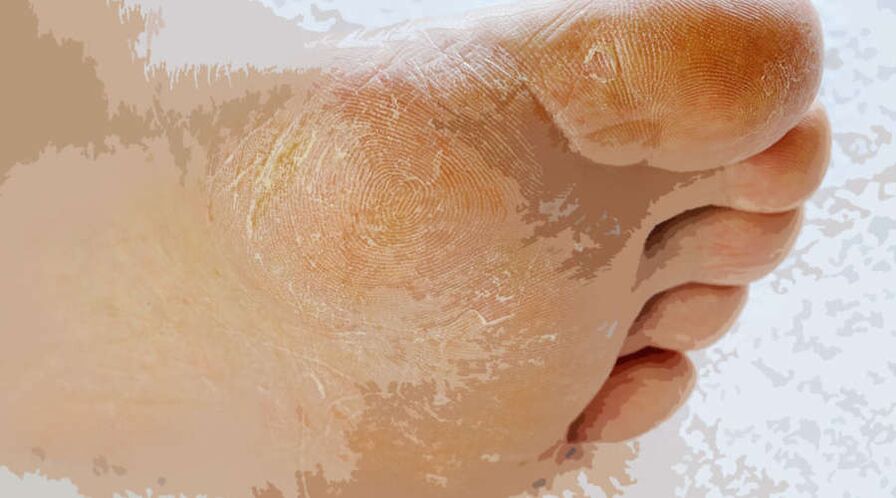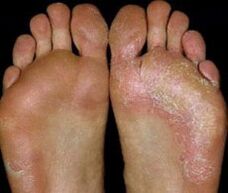
Foot fungal disease (ICD code 10 B35. 3) is a fungal infection of the leg skin caused by parasitic dermatophytes. It occurs in approximately 20% of adults. Infection occurs through slight wounds, scratches, abrasions, and wounds. Wet feet, diabetes and decreased immunity promote the development of the disease.
Among people suffering from endocrine disorders and immunodeficiency, the prevalence rate reaches 50%. More commonly, the disease progresses in a chronic form with alternating periods of remission and exacerbation. In 40-50% of cases, fungal diseases of the feet can cause onychomycosis or fungal infections of the nails.
Where did the infection happen and why?
Foot mycosis is a contagious disease that can be easily spread through direct contact with fungal carriers or through household items. For example, wearing shoes, socks, towels, manicure supplies, rubber mats in showers. In 70-95% of cases, the pathogen of foot mycosis is Trichophyton red (Tr. Rubrum).
Generally, infections occur in public places with high humidity, which provide favorable conditions for the propagation and spread of pathogens. These places include swimming pools, public showers, saunas, water parks, gym locker rooms. If a person infected with the fungus walks barefoot on the floor or has a carpet in the shower, he will leave infectious particles. If then a healthy person walks into this place barefoot, the pathogen will fall on his skin. In this case, the fungus does not always show up immediately and cause the characteristic symptoms of the disease. With strong immunity and no health problems, a person is still just a carrier of the infection, but at the same time he will not get sick.
Increased risk of fungus and foot mycosis:
- Damage to the integrity of the skin;
- Infringes on the blood supply of the limbs, which in turn affects the tissuesThe supply of oxygen and nutrients deteriorates, the regeneration process is slowed down, and local immunity is weakened;
- Diabetes, high blood sugar levels create favorable conditions for the growth of fungi and the development of infections;
- Excessive sweating;
- Dry skin can cause microcracks;
- Old age;
- Blood disease;
- Long-term use of antibiotics, Drugs that suppress immunity;
- Vitamin deficiency;
- Wear shoes that are impermeable to the air and produce a "greenhouse effect".
Symptoms and types of disease

Foot mycosis manifests in different ways. The type of pathogen and the severity of the lesion will affect the symptoms. The initial symptoms of the disease appear in the folds between the fingers and from there spread to the soles, sides, back of the feet and nails.
The photo shows the foot with fungal disease.
When the nail is infected, you will notice that the nail becomes thicker, loses its luster, and the plates become cloudy. The nails are yellowish, gray toned, brittle and chipped.
Early clinical symptoms of foot mycosis include dryness, peeling skin, painless cracks in the folds between the toes. This disease is called elimination. The initial peeling and cracking will not cause pain, itching or discomfort. Only a doctor can notice the initial unrepresented signs of a fungal infection. In addition to the erased foot, other clinical forms of foot fungal disease are also different, and each form has its own symptoms.
Scaly
In the scaly form of foot fungus, there is peeling between the toes and the folds on both sides. Usually, there are no signs of inflammation. There may be redness, damaged nails, itching, thickening of the stratum corneum, making the skin shiny. The nipple lines become more pronounced, and the skin surface becomes dry and covered with scaly scales. In this case, the patient will not feel itching or other discomfort.
Hyperkeratosis
Appears as a rash on the vault. The surface of the rash element is covered with gray-white layered scales. The epidermis is detached, a single vesicle. When merged with each other, the rash forms a vaguely large lesion that spreads all over the sole, including the sides and back. In addition to the exfoliated lesions, there are also areas of hyperkeratosis or thickened skin. They look like calluses with cracks on the top. Foot mycosis has a highly keratinized form, and the affected area is similar to psoriasis or eczema. A person is worried about dryness, itching, and sometimes pain.
Intermarginal
The form of intermarginal mycosis is similar to the symptoms of diaper rash. Therefore, the name is taken from lat. intertrigo-"diaper rash". More often, in the interval between the third and fourth, and fourth and fifth fingers, the skin is affected. It turned bright red and edema. The wound shed tears, forming deep and painful cracks. Unlike diaper rash, the lesions of triterminal mycosis are round with clear outlines, with white outlines separated along the edges of the epidermis. The person experiences itching, burning, soreness. The form of foot dystrophy of foot mycosis is multivesicular vesicles with thick apical processes, mainly located on the arch of the foot. The rash spreads to most areas of the sole and the space between the toes and the skin of the toes. Merge to form large bubbles. Instead of bursting bubbles, wet erosion occurs. As the inflammation increases, the skin becomes red and swollen. During the vesicle formation stage, the patient feels unbearable itching.
Diagnostic procedures
If you suspect that your feet have fungal disease, you need to go to a dermatologist. To confirm the diagnosis, the doctor will examine the legs and ask which symptoms bother the person and how long ago and after they appeared. Scrape from the affected area for microscopic analysis, and cultural studies to identify specific types of pathogens. In addition, your doctor may order blood tests.
How to treat foot fungal disease?
A mycologist or dermatologist is responsible for treating mycosis of the skin of the feet. Taking into account the clinical form of the disease, the severity of the disease, and visible changes, the doctor will choose the appropriate treatment.
Complications of fungal infections of the legs can lead to fungal infections of the hands. Mycosis of the feet can sometimes lead to secondary bacterial infections, especially when there are draped wounds on the skin.
Prescription topical fungicides (ointments, creams), oral tablets can fight fungi. Only topical treatment is effective for mild forms of foot mycosis. According to clinical guidelines, oral medications should be prescribed in severe cases.
If necessary, anti-inflammatory, drying, antiseptic, and anti-allergic drugs can be added to the treatment. These drugs can enhance the regeneration of damaged tissues. If there are signs of bacterial infection, antibiotics should be prescribed.
For onychomycosis, perform hardware cleaning of the fungus-infected area. For the subsequent processing of nails, a topical antifungal agent is prescribed: varnish, cream or ointment.
The duration of treatment ranges from two weeks to one month. If it affects not only the skin but also the nails, the treatment will be delayed. This is due to the fact that the nails grow slowly. In order to get rid of the infection, a perfectly healthy nail plate must be regrown.
Following the doctor's prescription, fungal diseases can be successfully treated. However, if you notice that the patient's condition has improved, the patient stops taking the medication, which will cause the recurrence of the infection and gradually change to a chronic form. Even if the symptoms of the disease have disappeared, it is necessary to complete the entire process.
It is very important in the treatment of foot fungal diseases, foot care, personal hygiene, diet and selection of comfortable shoes that will not harm the affected area.
How to prevent it?
In order to avoid or reduce the risk of mycosis of feet and nails, the following suggestions will help: Damage or reduced physical defenses;
If you find even slight peeling of the skin on your legs or cracks between your toes, it is worth testing for fungus. Early diagnosis and timely treatment will help avoid complications, extensive injuries, discomfort, pain while walking, and bacterial infections.





























